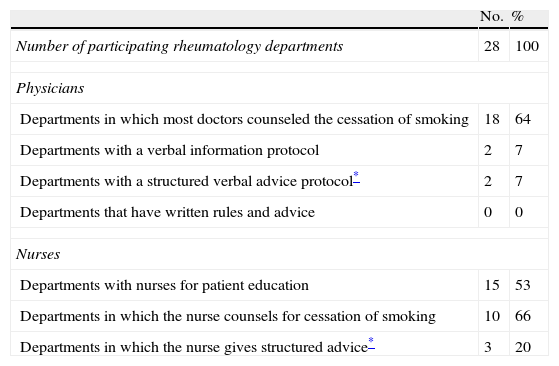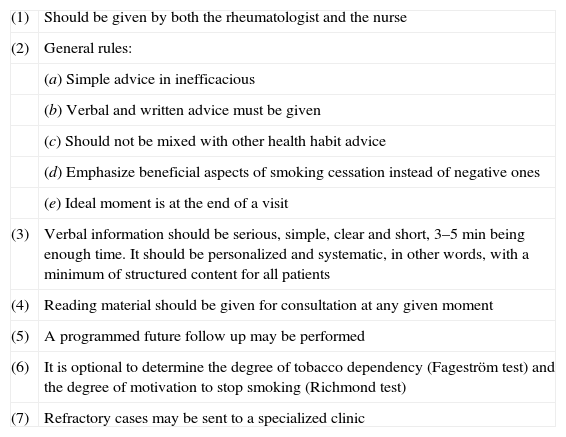Smoking is one of the main environmental factors involved in the pathogenesis of rheumatoid arthritis (RA) and is also associated with an increased incidence of rheumatoid nodules1 and, in general, a greater need for conventional and biologic treatment.2,3 To this we must add the extra risk of cardiovascular events in RA.4,5 We conducted a survey of Spanish rheumatology departments to evaluate the approach to smoking cessation advice by rheumatologists. The survey was completed by department heads and consisted of the following components: (a) number of physicians, (b) number of nurses involved in patient education, (c) cessation of smoking advice given to patients by the physician (most physicians, only some of the physicians, none of them), (d) counseling by the nurse (to the majority of smokers, some smokers, none), (e) the manner in which smoking cessation counseling is given by physicians and nurses (simple display, structured information for at least 3min), (f) existence of consensus in the department on how to give verbal and written information to patients, and (g) the existence of addiction clinics in the hospital. The survey was sent to 30 centers and was completed by 28. The geographic distribution covered 17 provinces and 11 Spanish regions. In one third of the centers only some physicians advised smoking cessation and, in the rest, most of the physicians did (Table 1). In two thirds of the services patient education nurses were available, and advised most patients on smoking cessation. The way that doctors and nurses advised smoking cessation was simply stating the fact in most centers. The nurses dedicated to patient education on tobacco addiction had specific office areas in 2 centers (13%). 22 cases (78%) provided a specific clinic for smokers in the hospital or other related areas. It is known that with an explicit verbal and written message from the physician up to 5%–10% of smokers ceased smoking in the months following the visit,6 and spontaneous dropouts were estimated around 2%–3%.6 Medical advice is the best cost/effectiveness intervention, although it has been observed that when the indication of quitting smoking is simple advice, the efficiency is low.6 Keep in mind that most of the patient records, but not all, pick up smoking habits. Moreover, if the physician is a smoker he may not give medical advice or do a less effective job than the doctor who is a non-smoker.7 Our results show that, although there is information about the harmful effect of tobacco in patients with arthritis, the way it used is not optimal. Departments need to be aware of how cheap and easy it is to give structured advice by physicians and nurses to all smokers, and that when several healthcare professionals deliver the message, efficiency is greater than when given by a single person.6Table 2 summarizes the generic standard advise for the cessation of smoking by patients.8,9 In conclusion, we must insist the rheumatologists advise patients of the need for smoking cessation, especially those with arthritis, connective tissue disease, and osteoporosis.
Results of the survey.
| No. | % | |
| Number of participating rheumatology departments | 28 | 100 |
| Physicians | ||
| Departments in which most doctors counseled the cessation of smoking | 18 | 64 |
| Departments with a verbal information protocol | 2 | 7 |
| Departments with a structured verbal advice protocol* | 2 | 7 |
| Departments that have written rules and advice | 0 | 0 |
| Nurses | ||
| Departments with nurses for patient education | 15 | 53 |
| Departments in which the nurse counsels for cessation of smoking | 10 | 66 |
| Departments in which the nurse gives structured advice* | 3 | 20 |
General rules for advising patients to stop smoking.
| (1) | Should be given by both the rheumatologist and the nurse |
| (2) | General rules: |
| (a) Simple advice in inefficacious | |
| (b) Verbal and written advice must be given | |
| (c) Should not be mixed with other health habit advice | |
| (d) Emphasize beneficial aspects of smoking cessation instead of negative ones | |
| (e) Ideal moment is at the end of a visit | |
| (3) | Verbal information should be serious, simple, clear and short, 3–5min being enough time. It should be personalized and systematic, in other words, with a minimum of structured content for all patients |
| (4) | Reading material should be given for consultation at any given moment |
| (5) | A programmed future follow up may be performed |
| (6) | It is optional to determine the degree of tobacco dependency (Fageström test) and the degree of motivation to stop smoking (Richmond test) |
| (7) | Refractory cases may be sent to a specialized clinic |
To doctors José J. Pérez-Venegas (Hospital de Jerez), Patricia E. Carreira (Hospital 12 de Octubre), Carlos Marras (Hospital Arrixaca), Santiago Muñoz (Hospital Infanta Sofía), Pilar Ahijado (Hospital Infanta Elena), Antonio Fernández-Nebro (Hospital Carlos Haya), Víctor Martínez-Taboada (Hospital Valdecilla), Javier de Toro (Hospital A Coruña), José Luis Andreu (Hospital Puerta de Hierro-Majadahonda), Federico Navarro (Hospital Virgen Macarena), Rafael Cáliz (Hospital Virgen de las Nieves), Joan M. Nolla (Hospital de Bellvitge), Javier Ballina (Hospital Central de Asturias), Raimon Sanmarti (Hospital Clínic), Indalecio Monteagudo (Hospital Gregorio Marañón), Sagrario Bustabad (Hospital Universitario de Canarias), José Rosas (Hospital de Villajoyosa), Jesús Tornero (Hospital de Guadalajara), José Luis Alvarez (Hospital Infanta Cristina), Julio Medina (Hospital de Palencia), Isidoro González Alvaro (Hospital La Princesa), Pere Benito (Hospital del Mar), Julio García Feito (Hospital Torrecárdenas), Juan J. Alegre (Hospital Dr. Peset), Eugenio de Miguel (Hospital La Paz) and José Luis Marenco (Hospital de Valme).
To nurses Amelia Carbonell (Hospital San Juan-Alicante), Isabel Padró (Hospital del Mar) and Encarnación Roncal (Hospital La Paz).
Please cite this article as: Naranjo A, et al. Consejo del reumatólogo sobre deshabituación tabáquica: ¿estamos actuando adecuadamente con los pacientes fumadores? Reumatol Clin. 2012;8:158–61.







